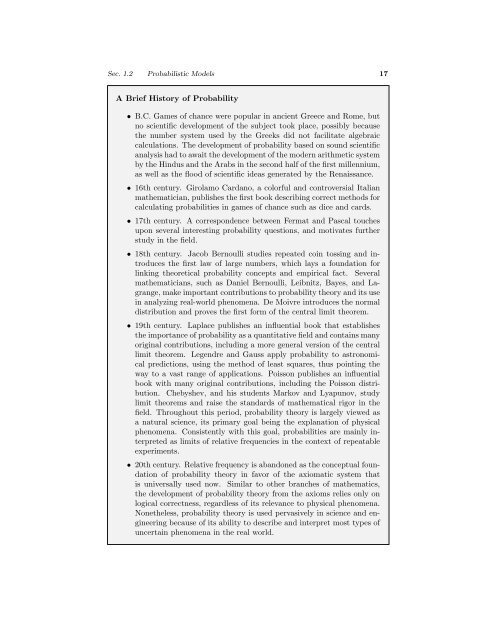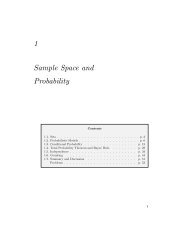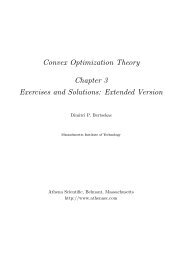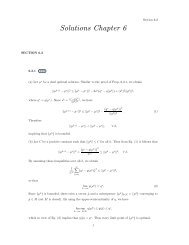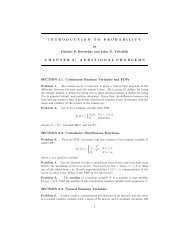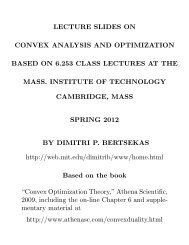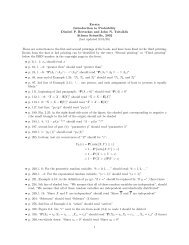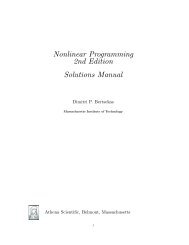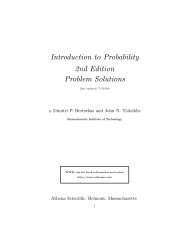Introduction to Probability, by Dimitri P ... - satrajit mukherjee
Introduction to Probability, by Dimitri P ... - satrajit mukherjee
Introduction to Probability, by Dimitri P ... - satrajit mukherjee
You also want an ePaper? Increase the reach of your titles
YUMPU automatically turns print PDFs into web optimized ePapers that Google loves.
Sec. 1.2 Probabilistic Models 17<br />
A Brief His<strong>to</strong>ry of <strong>Probability</strong><br />
• B.C. Games of chance were popular in ancient Greece and Rome, but<br />
no scientific development of the subject <strong>to</strong>ok place, possibly because<br />
the number system used <strong>by</strong> the Greeks did not facilitate algebraic<br />
calculations. The development of probability based on sound scientific<br />
analysis had <strong>to</strong> await the development of the modern arithmetic system<br />
<strong>by</strong> the Hindus and the Arabs in the second half of the first millennium,<br />
as well as the flood of scientific ideas generated <strong>by</strong> the Renaissance.<br />
• 16th century. Girolamo Cardano, a colorful and controversial Italian<br />
mathematician, publishes the first book describing correct methods for<br />
calculating probabilities in games of chance such as dice and cards.<br />
• 17th century. A correspondence between Fermat and Pascal <strong>to</strong>uches<br />
upon several interesting probability questions, and motivates further<br />
study in the field.<br />
• 18th century. Jacob Bernoulli studies repeated coin <strong>to</strong>ssing and introduces<br />
the first law of large numbers, which lays a foundation for<br />
linking theoretical probability concepts and empirical fact. Several<br />
mathematicians, such as Daniel Bernoulli, Leibnitz, Bayes, and Lagrange,<br />
make important contributions <strong>to</strong> probability theory and its use<br />
in analyzing real-world phenomena. De Moivre introduces the normal<br />
distribution and proves the first form of the central limit theorem.<br />
• 19th century. Laplace publishes an influential book that establishes<br />
the importance of probability as a quantitative field and contains many<br />
original contributions, including a more general version of the central<br />
limit theorem. Legendre and Gauss apply probability <strong>to</strong> astronomical<br />
predictions, using the method of least squares, thus pointing the<br />
way <strong>to</strong>avast range of applications. Poisson publishes an influential<br />
book with many original contributions, including the Poisson distribution.<br />
Che<strong>by</strong>shev, and his students Markov and Lyapunov, study<br />
limit theorems and raise the standards of mathematical rigor in the<br />
field. Throughout this period, probability theory is largely viewed as<br />
a natural science, its primary goal being the explanation of physical<br />
phenomena. Consistently with this goal, probabilities are mainly interpreted<br />
as limits of relative frequencies in the context of repeatable<br />
experiments.<br />
• 20th century. Relative frequency is abandoned as the conceptual foundation<br />
of probability theory in favor of the axiomatic system that<br />
is universally used now. Similar <strong>to</strong> other branches of mathematics,<br />
the development of probability theory from the axioms relies only on<br />
logical correctness, regardless of its relevance <strong>to</strong> physical phenomena.<br />
Nonetheless, probability theory is used pervasively in science and engineering<br />
because of its ability <strong>to</strong> describe and interpret most types of<br />
uncertain phenomena in the real world.


